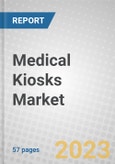Report Scope
The current report offers a detailed picture of the medical kiosks market. This report highlights the current and future market potential for global medical kiosks and provides a detailed analysis of the competitive environment, regulatory scenario, drivers, restraints, opportunities and trends in the market, emerging technologies, future analysis and impact of wars on the market. The report also covers market projections through 2028 and key market players. This report discusses medical kiosks and their various resources. It covers the overall medical kiosk market, including type and end user. Furthermore, a complete regional analysis of the market is presented in the report. By type, the segment has been categorized into check-in kiosk, payment kiosk, way-finding kiosk, telemedicine kiosk, self-service kiosk and others. Based on end user, the medical kiosks market has been segmented into hospitals, clinics, laboratories, pharma stores and others.
The market has been segmented based on geography into: North America, Europe, Asia-Pacific, and the Rest of the World (RoW), which includes South America, the Middle East and Africa (MEA). Detailed analyses of major countries (the U.S., Canada, Germany, the U.K., France, Italy, Japan, China and India) are covered in regional segments. For market estimates, data has been provided for 2022 as the base year, with forecasts for 2023 through 2028. Estimated values are based on revenue from medical kiosks companies as total revenues. Projected and forecasted revenue values are in constant U.S. dollars that have not been adjusted for inflation.
Report Includes
- An overview of the global market for medical kiosks
- Analysis of global market trends, featuring historical revenue data for 2022, estimates for 2023, forecasts for 2024 and 2026. and projections of compound annual growth rates (CAGRs) through 2028
- Evaluation of the current market size and revenue growth prospects, accompanied by a market share analysis by type, end user and geographical region
- Coverage of evolving technologies, the current and future market potential, and the regulatory framework and reimbursement scenarios
- Review of patents, product pipeline, and ESG trends related to medical kiosks
- Market share analysis of the key companies and coverage of mergers & acquisitions, joint ventures, collaborations and partnerships
- Profiles of leading market participants
Table of Contents
Executive Summary
In recent years, the global medical kiosks market has advanced significantly. Medical kiosks represent a notable breakthrough in the field of medical technology, facilitating enhanced accessibility to healthcare services for individuals across many different patient groups. Kiosks, also known as electronic self-service machines, have emerged as convenient and efficient access to healthcare screenings for the public. Certain systems are utilized by medical facilities and healthcare professionals primarily for basic check-in purposes, while others exhibit a higher level of sophistication and functionality. Medical kiosks have the potential to offer valuable insights into an individual’s overall health status, serving to identify and notify patients of any potential health concerns that may necessitate additional medical attention. Olea Kiosks, Kiosk Information System, and Diebold Nixdorf are prominent players in the field of medical technology.
The deployment of health kiosks in physical spaces such as retail health clinics and educational institutions serves to detect and alert individuals about potential health issues through early detection screening. Diagnostic tools have succeeded in identifying health concerns such as weight issues and hypertension (high blood pressure). Notably, many companies have emerged to offer supplementary screenings, thus expanding the range of early detection techniques. For example, the integration of eye testing capabilities into kiosks offers a promising opportunity for early detection of vision changes. It also eliminates the need for individuals to initially consult an optometrist or doctor. Kiosks can also
provide follow-up medical resources and other information for users seeking additional assistance.
The success of health kiosks can be attributed to their significant benefits. Kiosks facilitate patient empowerment by granting them autonomy over their health screenings, offering expedited and flexible options for completion at the patient’s convenience. The implication of this statement is that patients are required to seek medical attention from their healthcare provider solely if the kiosk identifies a potential health concern. The implementation of this technology benefits both healthcare providers and patients by yielding time and cost savings.
The ability to exert control over healthcare experiences has been found to substantially reduce the seemingly intimidating nature of such encounters, thereby reducing the initial stress commonly associated with attending appointments. For many individuals, the preference for in-person visits to healthcare providers remains prevalent. However, the emergence of medical kiosks has introduced a novel approach to conducting health check-ups, which has garnered significant appeal among a substantial patient population. The market offers a diverse range of kiosks, each designed to cater to specific demographics and high-footfall environments. These kiosks come in various shapes and sizes, providing flexibility and customization options for businesses seeking to optimize their customer engagement strategies.
Companies Mentioned
- Diebold Nixdorf Inc.
- Dynatouch
- Frank Mayer And Associates Inc.
- Kiosk Information Systems
- Kiosks4Business Ltd.
- LG Electronics Inc.
- Meridian Kiosks Llc
- NCR Voyix Corp.
- Olea Kiosks Inc.
- Pitney Bowes Inc.
- Redyref Interactive Kiosks
- Source Technologies Llc
- Xiphias Software Technologies Pvt. Ltd.
- Zebra Technologies Corp.








